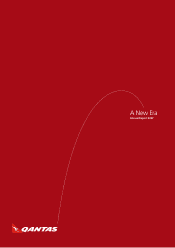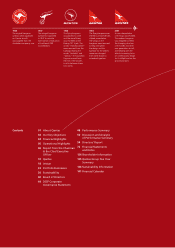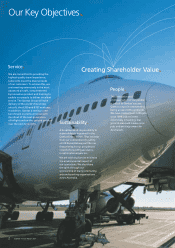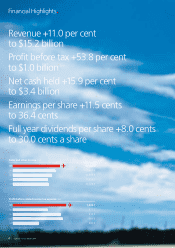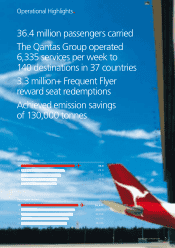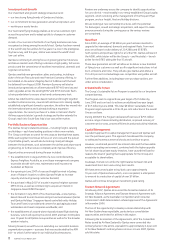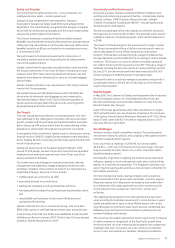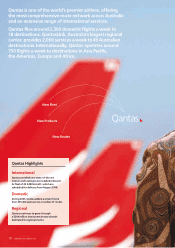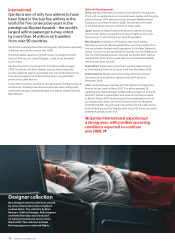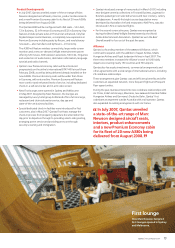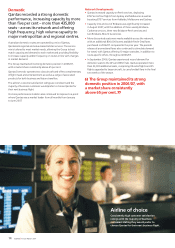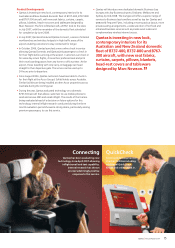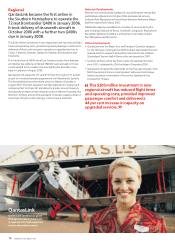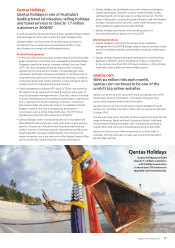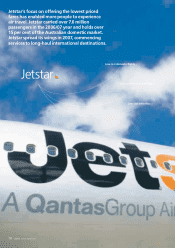Qantas 2007 Annual Report Download - page 10
Download and view the complete annual report
Please find page 10 of the 2007 Qantas annual report below. You can navigate through the pages in the report by either clicking on the pages listed below, or by using the keyword search tool below to find specific information within the annual report.8Qantas |Annual Report 2007
Investment and Growth
Our investment and growth strategy is based around:
•our two strong flying brands of Qantas and Jetstar;
•our commitment to new generation aircraft and product; and
•working our assets harder.
Our two brand flying strategy enables us to serve customers right
across the spectrum and to adapt quickly to changes in customer
demand.
A mark of our success is that both of our flying businesses are now
recognised as being among the world’s best. Qantas has been named
in the world’s top five airlines for five years in a row in the prestigious
Skytrax survey, and this year, Jetstar was named the world’s best
low cost airline.
Qantas is continuing its strong focus on growing premium business
and leisure markets and offering customers a high quality, full service
product and the convenience of excellent international, domestic and
regional connections.
Qantas unveiled new generation cabins and seating, including a
state-of-the art First suite and new Premium Economy offering, to
be installed on the airline’s flagship fleet of A380 aircraft that will
be delivered from August 2008. Premium Economy will also be
introduced progressively on all international B747-400 services and
cabin upgrades across the existing B767 and B737 domestic fleets
is being undertaken to ensure a fresh and contemporary look.
Jetstar has redefined the value-based market and brought together
excellent customer service, new aircraft and low costs. Having rapidly
established a significant domestic operation, the airline has moved into
the international arena and is already looking at expansion
opportunities. Our recent purchase of a stake in Vietnam’s Pacific
Airlines supports Jetstar’s growth strategy and further extends the
Group’s reach into South-East Asia’s low cost airline market.
Portfolio Business Opportunities
The Qantas Group’s related businesses – including freight, catering
and holidays – each have leading positions in their own markets.
The Group continues to search for new ways to develop these assets.
While each segment continues to focus on unit costs and the pursuit
of profitable growth, we will also be looking closely at linkages
between the businesses, such as between the airlines and airports and
engineering, to further reduce complexity and improve efficiency.
Opportunities announced during the year included:
•the establishment in August 2006 of a new controlled entity,
Express Freighters Australia, as a wet lease management company
to provide aircraft with crew, maintenance and insurance to
Australian air Express;
•the opening in June 2007 of a second freight terminal in Sydney,
at an off-airport location, to allow Qantas Freight to increase
capacity and meet growing customer demand;
•the purchase in May 2007 of a stake in express freighter operator
DPEX China, as well as commencing to acquire an interest in
Singapore-based DPEX Transport;
•the formation in July 2007 of Tour East Australia, a new Sydney-
based inbound tourism business and joint venture between Qantas
and Qantas Holidays’ Singapore-based controlled entity Holiday
Tours and Travel, to provide land content for packaging by travel
wholesalers and travel companies worldwide; and
•the establishment of a stand-alone Australia-based flight training
business, which will open by the end of 2007 and train 3,000 pilots
over 10 years for all Qantas Group airlines as well as for the broader
aviation industry.
Moving forward, we will focus on extending our successful business
segmentation program – a process that was accelerated by the APA
bid – to unlock further value in our individual business assets.
Reviews are underway across the company to identify opportunities
for us to do this – most notably in our newly established Group Loyalty
segment, which is looking at the management of the Frequent Flyer
program, and our freight, fleet and holiday divisions.
We are looking at new ownership structures, with the potential
for demergers, as well as strategic acquisitions, and expect to make
announcements during the coming year as the various reviews
are completed.
New Fleet
Since 2000, an average of $2 billion per year has been invested to
upgrade the international, domestic and regional fleets. From next
year, we will start to take delivery of 20 A380s and 65 B787s
(with options and purchase rights for a further 50). Qantas will launch
the A380, while Jetstar will be the Group’s – and Australia’s – launch
airline for the B787, taking the first 15 aircraft.
These new generation aircraft will allow us to deliver a new standard
of flying to our customers as well as offer significant reductions in fuel
burn, emissions and noise. They will also give Qantas and Jetstar a
15 to 20 per cent cost advantage over competitors using older aircraft.
Further fleet additions, including lease over purchase options, are
under active consideration.
A Sustainable Future
The Group’s Sustainable Future Program is essential to our long-term
competitiveness.
The Program met its original three year target of $1.5 billion by
June 2006 and is on track to achieve an additional two year target
of $1.5 billon by June 2008. This total $3 billion Sustainable Future
Program target represents a 20 to 25 per cent reduction in the overall
Group cost base.
During 2006/07, the Program delivered efficiencies of $753 million
across a range of areas including distribution, improved recovery of
customer service costs, process efficiencies and productivity initiatives.
Capital Management
A prudent approach to capital management has served Qantas well
over the past seven years. This approach has allowed the company
to withstand numerous external shocks and continue to grow.
However, a sustained period of low interest rates and the favourable
aviation operating environment, combined with the higher appetite
for risk shown by private equity investors, have caused the Board to
reassess the level of gearing that is appropriate for the Group and
acceptable to shareholders.
As always, the task is to strike the right balance between risk and
reward and short-term versus long-term results.
We have announced a plan to buy back up to approximately
10 per cent of Qantas shares which, once completed, is anticipated
to amount to a reduction of capital of over $1 billion.
Qantas will continue to target an investment grade rating.
Tasman Network Agreement
In February 2007, Qantas announced the formal termination of its
Strategic Alliance Agreement and Tasman Network Agreement with
Air New Zealand, as the Australian Competition and Consumer
Commission’s draft determination refused approval of the Agreement
in November 2006.
The loss of the opportunity to develop a closer relationship with
Air New Zealand was regrettable, particularly as consolidation
opportunities are limited for airlines in this region.
Following the termination of the Agreements, all of the Convertible
Notes issued by Air New Zealand to Qantas were converted into
ordinary shares in the airline, equivalent to approximately 4.2 per cent
of Air New Zealand’s ordinary shares on issue. In June 2007, Qantas
sold this stake.

